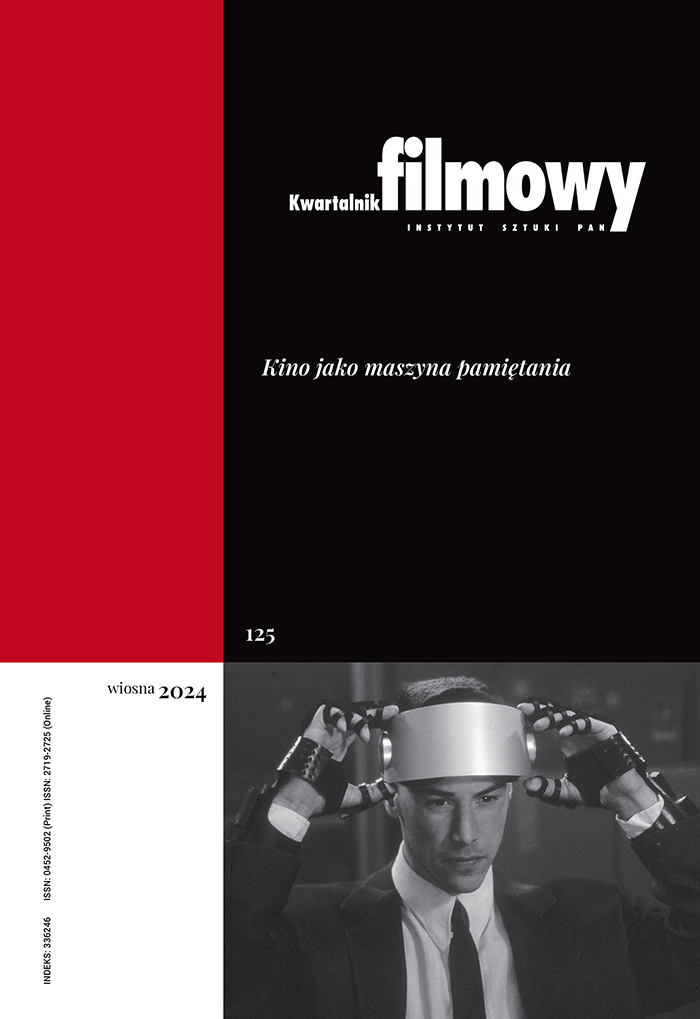They Are Not There: The Body of a Pop Star in “Superstar: The Karen Carpenter Story” and “I'm Not There” by Todd Haynes
Abstract
In Todd Haynes’ films corporeality of the characters takes center-stage. The body is an area on which one’s identity is built, and is the carrier of that identity. However Haynes does not present the body as a sign of psychological depth of the character; it also does not have a pre-discursive character, it is never natural and self-determining. Just like identity, the body is only a construct shaped by the pressure of a given social and cultural order. The author, with the help of the analysis of two of Haynes’ films - Superstar: The Karen Carpenter Story (1988) and I’m Not There (2007), tries to describe the director’s artistic strategy. In Superstar, a film telling the story of Karen Carpenter, the pop star who died in 1983 as a result of anorexia, all of the roles were given to Barbie dolls. In I’m Not There, an experimental biography of Bob Dylan, the main role was written for six actors, including a woman and a black teenage boy. The body fulfils in these films a function of a sign, it distances the viewer, it makes him interpret rather than identify with the characters. The “body” of the movie also plays here a considerable role: Haynes juggles the conventions and film schemas, refers to film genres, uses cliches and borrowings. Bodies treated in this manner show a remarkable interpretative potential of the films of the American director.
Keywords:
Todd Haynes, Bob Dylan, Karen CarpenterReferences
Clover, Joshua. 2008. The End. "Film Quarterly" 3.
DOI: https://doi.org/10.1525/fq.2008.61.3.6
Google Scholar
Kwiatkowska, Paulina. 2011. Somatografia. Ciało w obrazie filmowym. Kraków: korporacja ha!art.
Google Scholar
Landy, Marcia. 2007. Storytelling and Information in Todd Haynes' Films. W: Morrison, James. The Cinema of Todd Haynes: All That Heaven Allows. London & New York: Wallflower Press.
Google Scholar
Lott, Eric. 2008. Perfect is Dead: Karne Carpenter, Theodor Adorno, and the Radio; Or, if Hooks Would Kill. "Criticism" 2.
Google Scholar
MacDonald, Scott. 2009. From Underground to Multiplex: An Interview with Todd Haynes. "Film Quarterly" 3.
DOI: https://doi.org/10.1525/fq.2009.62.3.54
Google Scholar
Naremore, James. 2012. Film Acting and the Arts of Imitation. "Film Quarterly" 4.
DOI: https://doi.org/10.1525/fq.2012.65.4.34
Google Scholar
Pitrus, Andrzej. 2004. Nam niebo pozwoli. O filmowej i telewizyjnej twórczości Todda Haynesa. Kraków: Rabid.
Google Scholar
Porton, Richard. 2007. The Many FAces of Bob Dylan: An Interview with Todd Haynes. "Cineaste" 1.
Google Scholar
Authors
Karolina Kosińskakwartalnik.filmowy@ispan.pl
Institute of Art, Polish Academy of Sciences Poland
Absolwentka kulturoznawstwa (specjalność filmoznawcza) w Instytucie Sztuk Audiowizualnych Uniwersytetu Jagiellońskiego. Pracę magisterską dotyczącą form buntu w kinie brytyjskim obroniła pod kierunkiem prof. dr. hab. Tadeusza Lubelskiego w 2002 roku. Pracę doktorską na temat postaci androgynicznej w brytyjskim filmie i kulturze popularnej obroniła w 2008 roku (promotor: prof. dr hab. Andrzej Pitrus) również w ISzA UJ. Od 2003 roku redaktorka „Kwartalnika Filmowego”.
Statistics
Abstract views: 765PDF downloads: 151
License
Copyright (c) 2013 Karolina Kosińska

This work is licensed under a Creative Commons Attribution 4.0 International License.
The author grants the publisher a royalty-free non-exclusive licence (CC BY 4.0) to use the article in Kwartalnik Filmowy, retains full copyright, and agrees to identify the work as first having been published in Kwartalnik Filmowy should it be published or used again (download licence agreement). The journal is published under the CC BY 4.0 licence. By submitting an article, the author agrees to make it available under this licence.
In issues from 105-106 (2019) to 119 (2022) all articles were published under the CC BY-NC-ND 4.0 licence. During this period the authors granted a royalty-free non-exclusive licence (CC BY-ND 4.0) to use their article in „Kwartalnik Filmowy”, retained full copyright, and agreed to identify the work as first having been published in our journal should it be published or used again.
Most read articles by the same author(s)
- Karolina Kosińska, Editorial , Kwartalnik Filmowy: No. 109 (2020): Architectural Space in Film
- Karolina Kosińska, Editorial , Kwartalnik Filmowy: No. 130 (2025): New Genre Identity
- Karolina Kosińska, Editorial , Kwartalnik Filmowy: No. 113 (2021): Film and Technology
- Karolina Kosińska, Editorial , Kwartalnik Filmowy: No. 125 (2024): Cinema as a Memory Machine
- Karolina Kosińska, Editorial , Kwartalnik Filmowy: No. 116 (2021): Cinema and Social Identity
- Karolina Kosińska, Editorial , Kwartalnik Filmowy: No. 108 (2019): Film Production and Distribution
- Karolina Kosińska, Editorial , Kwartalnik Filmowy: No. 111 (2020): Senses and Affects
- Karolina Kosińska, Editorial , Kwartalnik Filmowy: No. 119 (2022): (New) Film Theory
- Karolina Kosińska, Editorial , Kwartalnik Filmowy: No. 118 (2022): One Take
- Karolina Kosińska, Editorial , Kwartalnik Filmowy: No. 115 (2021): Form Film, Content Film











